Automated External Defibrillator (AED) Market Size
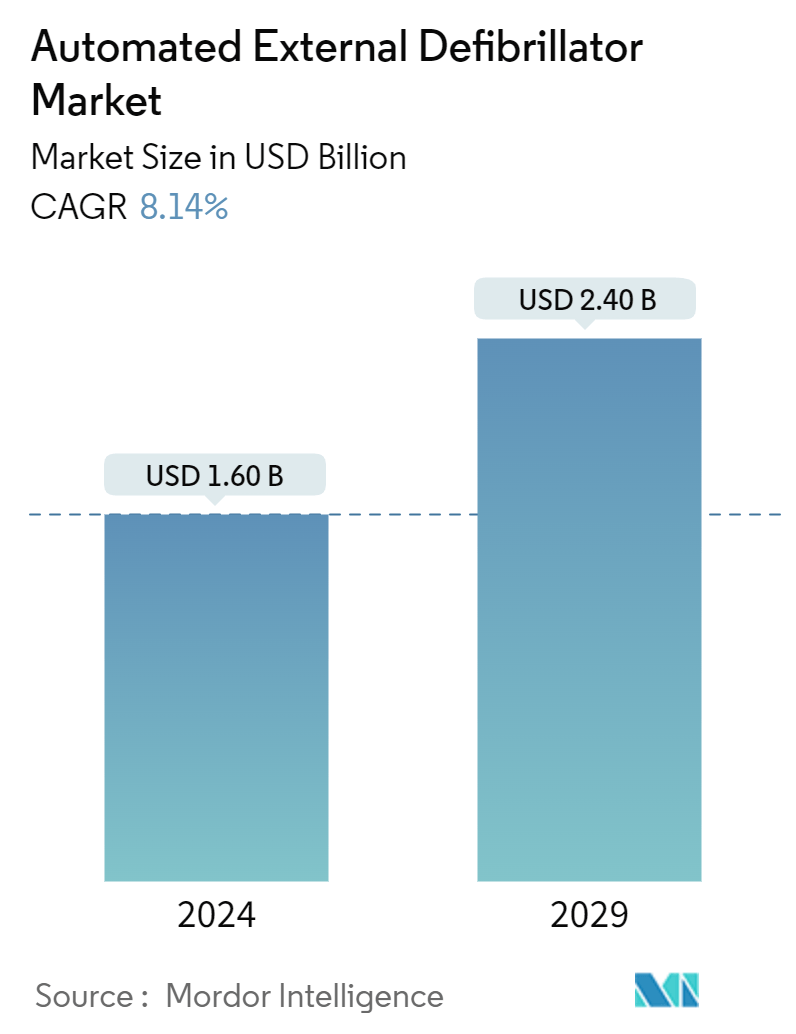
| Study Period | 2019 - 2029 |
| Market Size (2024) | USD 1.60 Billion |
| Market Size (2029) | USD 2.40 Billion |
| CAGR (2024 - 2029) | 8.14 % |
| Fastest Growing Market | Asia Pacific |
| Largest Market | North America |
Major Players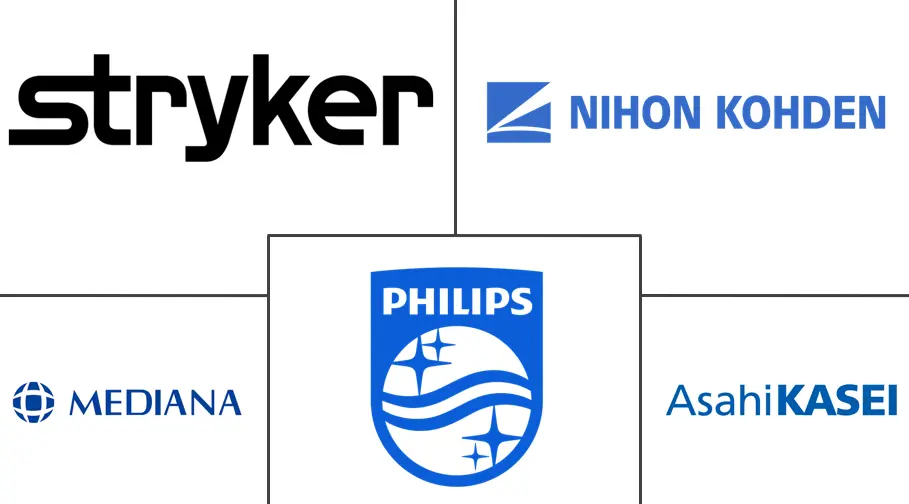
*Disclaimer: Major Players sorted in no particular order |
Need a report that reflects how COVID-19 has impacted this market and its growth?
Automated External Defibrillator (AED) Market Analysis
The Automated External Defibrillator Market size is estimated at USD 1.60 billion in 2024, and is expected to reach USD 2.40 billion by 2029, growing at a CAGR of 8.14% during the forecast period (2024-2029).
The major factors driving the automated electronic defibrillator market growth include the increasing prevalence of cardiac diseases, the rising geriatric population, and technological advancements in the field, supported by increasing investments from market players.
The high prevalence of cardiovascular diseases is propelling the growth of the automated external defibrillator market. For instance, coronary artery disease has risen at a high rate in recent years. According to a report published by the Centers for Disease Control and Prevention in May 2023, coronary heart disease is the most prevalent form of heart disease. Approximately 5% of adults aged 20 and older, or 1 in 20, are affected by coronary artery disease (CAD). In 2021, adults under the age of 65 accounted for about 20% of deaths resulting from CAD.
According to the same source, every year, about 850,000 people in the United States have a heart attack. Among these, 605,000 have had their first heart attacks, and over 200,000 people have already had a heart attack. The increasing prevalence of coronary artery disease, coupled with the high incidence of heart attacks, is driving the demand for automated external defibrillators due to their crucial role in providing timely intervention and potentially saving lives in cardiac emergencies.
As technology evolves at an unprecedented pace, the landscape of life-saving interventions, including automated external defibrillators (AEDs), is transforming. For instance, according to an article published by My CPR Now1 in August 2023, the latest automated defibrillator technology incorporates features such as IoT integration, AI algorithms for enhanced diagnostics, and telemedicine integration, making AEDs smarter and more effective in cardiac emergency responses.
These advancements are driving the growth of the automated external defibrillator market by increasing accessibility, improving outcomes through personalized responses, and facilitating remote guidance from medical professionals, thereby enhancing the overall effectiveness and integration of AEDs into emergency medical care systems.
In recent years, there has been a rise in product development and the launch of automated external defibrillators. For instance, in March 2024, Stryker launched two new products: LIFEPAK CR2 automated external defibrillator (AED) for cardiac care and Evacuation Chair for emergency patient evacuation.
In March 2024, Schiller introduced the FRED easy G2, the new automated external defibrillator. The FRED easy G2 is CE-certified by MDR. Schiller’s FRED-accessible G2 defibrillator is designed for basic and advanced life support. It guides the rescuer through all the interventions. The device is compact, lightweight, smart, and ready for action and perfectly complements every emergency kit. It offers mobility and flexibility in a time-critical situation.
Strategic government initiatives such as the installation of AED in public places are expected to increase its demand, thereby boosting market growth. For instance, in July 2023, the Uttar Pradesh government announced its plan to install automated external defibrillators (AEDs) in all government buildings and malls for patients with cardiac problems who require timely care in case of cardiac arrest. This initiative was planned to launch in August 2023 to improve the health infrastructure and facilities in Uttar Pradesh.
Thus, the automated external defibrillators market is expected to experience growth over the forecast period owing to the rising burden of cardiovascular diseases and the increasing launch of advanced automated external defibrillators. However, factors such as stringent regulations and lack of awareness and early corrective measures about sudden cardiac arrest may hinder the growth of the studied market over the forecast period.
Automated External Defibrillator (AED) Market Trends
Fully Automated External Defibrillators are Expected to Hold a Significant Share in the Market Over the Forecast Period
Fully automated external defibrillators (FAEDs) analyze the heart's rhythm and deliver a defibrillation shock without user intervention if commanded by the device software.
A few examples of FAEDs are the ZOLL AED Plus Fully Automatic and the Lifeline Auto AED. These devices automatically detect a shockable heart rhythm and administer the shock independently, eliminating the need for the rescuer to push a button. They provide real-time feedback on the depth and rate of chest compressions, ensuring the delivery of high-quality cardiopulmonary resuscitation (CPR) during a rescue.
Various research studies have shown the benefits of FAEDs in quick recovery of cardiac complications in patients. For instance, as per the article published in January 2024 in the Annals of Emergency Medicine journal1, the researchers showed that sudden cardiac arrest issues were not even resolved since the widespread public availability of semi-automated external defibrillators (AEDs) and the teaching of nonbreathing cardiopulmonary resuscitation (CPR) procedures. However, the introduction of the prearrest protocol and the at-home use of fully automated external defibrillators in select cardiac patients reduced the arrest-to-shock interval to under 1 minute and may eliminate the need for CPR in some cases. Thus, owing to such advantages offered by the FAEDs over SAEDs, their demand is likely to rise, leading to segment growth over the forecast period.
The importance of timely use of FAEDs is one of the major factors that lead to the recovery of cardiac complications. People accurately utilize FAEDs for this significant reason. For instance, as per the article published in July 2023 in the Healthcare Delivery, Economics, and Global Health Journal2, the researchers demonstrated that early use of fully automated external defibrillators (AEDs) improved outcomes in out-of-hospital cardiac arrest (OHCA) in Great Britain. Thus, considering such advantages offered by FAEDs, they are expected to support the segment growth over the forecast period.
The rising company collaborations, product launches, funding activities, and regulatory approvals are anticipated to drive the segment growth over the forecast period. For instance:
In January 2023, Avive Solutions Inc. received the US Food and Drug Administration (FDA) pre-market approval (PMA) for its Avive AED, a unique automated external defibrillator (AED). Avive Connect AED is designed for easy placement in a variety of locations, optimized for maximum connectivity, and extensively tested for ease of use. Avive simplifies AED monitoring and maintenance for its customers through daily remote monitoring of their fleet of devices using Avive’s REALConnect Platform.
In June 2023, organizations across England were invited to bid for a share of GBP 1 million (USD 1.2 million) of government funding to buy life-saving automated defibrillators for community spaces like town halls, local parks, or post offices. Hence, such funding activities and government support related to AEDs, including FAEDs, are expected to fuel the segment’s growth over the forecast period.
Therefore, owing to the above-mentioned factors, such as the adoption of FAEDs in cardiac arrhythmia management, increased research studies showing the benefits of FAEDs over SAEDs, product launches, and favorable government support, the market is expected to witness notable growth over the forecast period.
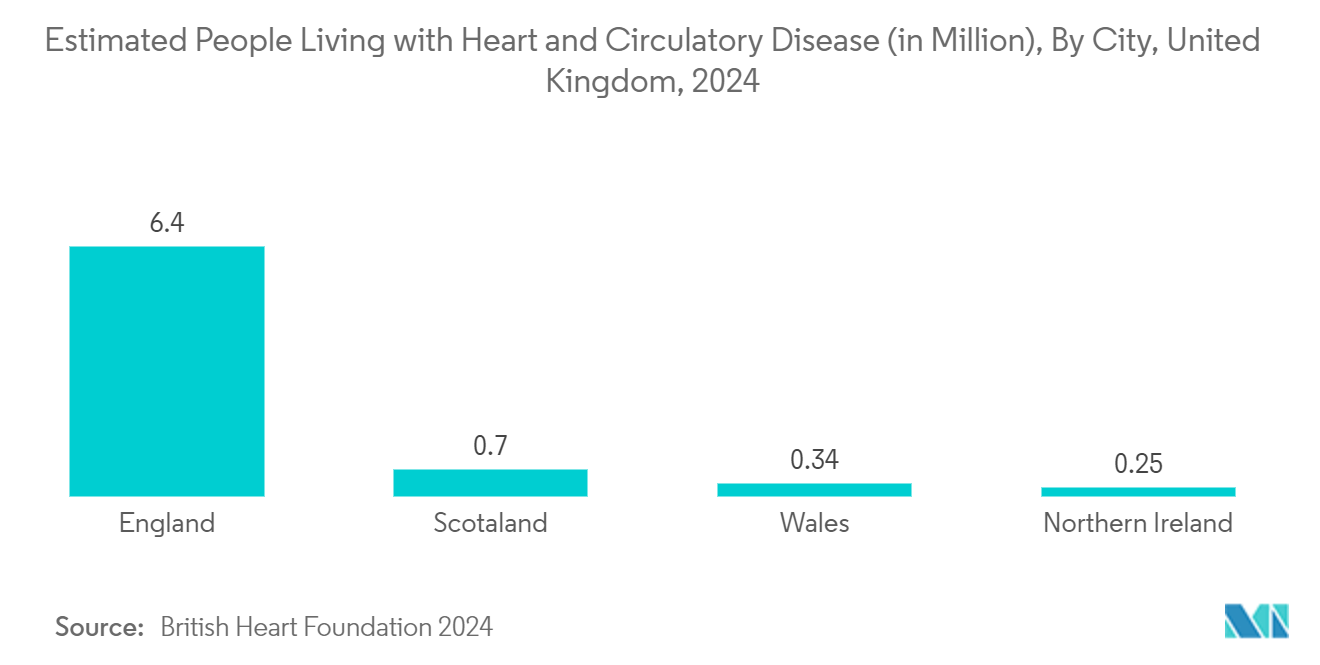
North America is Expected to Hold a Major Market Share Over the Forecast Period
The North American automated external defibrillators market is expected to grow during the forecast period due to the high burden and increasing prevalence of cardiovascular diseases, new product launches, and the emerging number of key market players in the region.
The increasing prevalence of cardiovascular diseases such as heart attack, heart failure, and coronary heart disease, among others, is one of the significant factors driving the market growth over the forecast period. For instance, according to the data updated by the Centers for Disease Control and Prevention in May 2023, every 40 seconds, a heart attack occurs in the United States. About 805,000 Americans experience a heart attack each year. Hence, the rising burden of cardiovascular diseases in the coming years will increase the demand for automated external defibrillators, elevating the market growth over the forecast period.
Cardiovascular diseases are one of the common disorders, with an estimated prevalence of 30%–40% in the Canadian population. Owing to the increasing prevalence of cardiovascular diseases such as heart attack, heart failure, hypertensive heart disease, and arrhythmia, the necessity for early treatment is likely to rise, which is expected to bolster the automated external defibrillator market in the country. For instance, according to the July 2022 update by Heart Disease in Canada, about 1 in 12 (or 2.6 million) Canadian adults age 20 and over live with diagnosed heart disease. Considering the country's high number of heart disease cases, the demand for automated external defibrillators is expected to rise, leading to market growth over the forecast period.
Awareness campaigns and government initiatives to promote the importance of automated external defibrillators, which facilitate market growth. For instance, according to the data updated by the Association of State and Territorial Health Officials in February 2023, several states in the United States introduced legislation to require the placement of automated external defibrillators (AEDs) in specific publicly accessible locations, including highway rest areas, county government buildings all public safety vehicles, hotels, urgent care, and retail health clinics.
Key market players are continuously launching innovative products and product approvals from regulatory bodies in the country, which is expected to bolster the demand for automated external defibrillators over the forecast period. For instance, in March 2024, Stryker launched two new products: LIFEPAK CR2 automated external defibrillator (AED) for cardiac care and Evacuation Chair for emergency patient evacuation. The LIFEPAK CR2 is a revolutionary defibrillator designed to empower rescuers to provide high-quality CPR and deliver instant shock during sudden cardiac arrest (SCA) emergencies. In January 2023, Avive Solutions Inc. received the US Food and Drug Administration (FDA) approval for its Avive AED, a unique automated external defibrillator (AED).
Hence, owing to the increase in cardiovascular disease, the strong foothold of key market players, and their continuous involvement in product launches and awareness campaigns by the government to promote the importance of automated external defibrillators, the North American market is expected to witness notable growth over the forecast period.
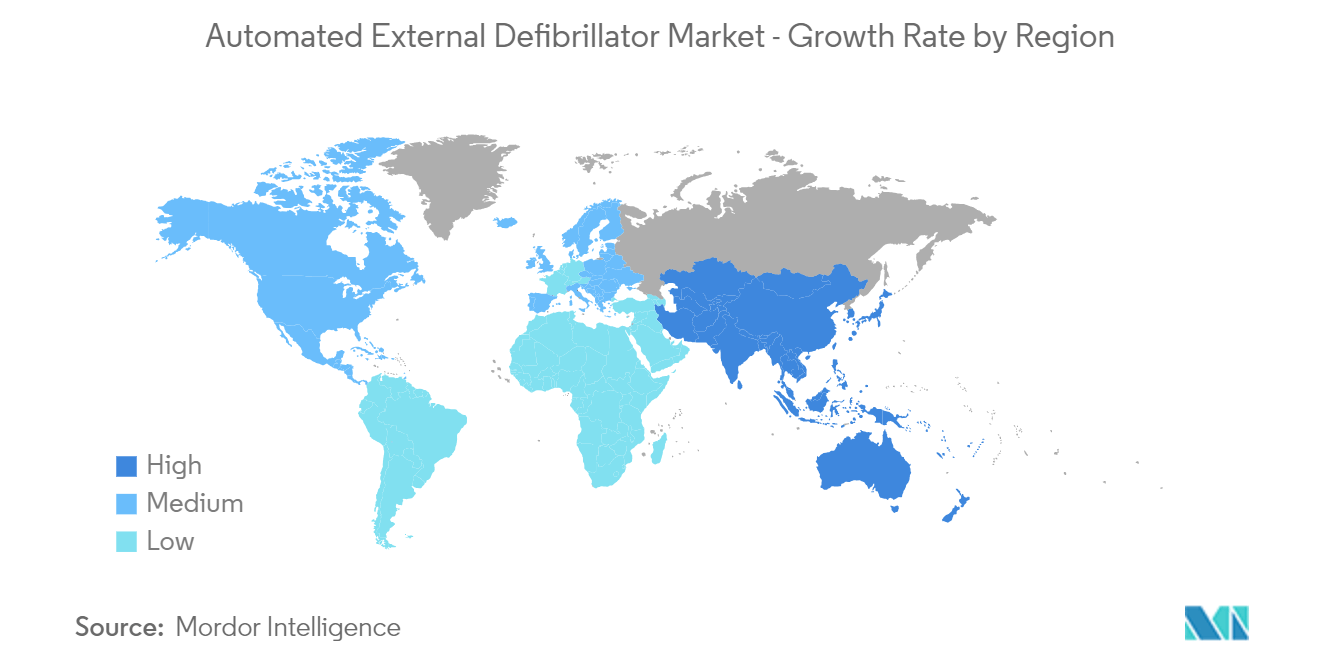
Automated External Defibrillator (AED) Industry Overview
The automated external defibrillator market is moderately competitive, with the presence of a few major players like Asahi Kasei Corporation, Koninklijke Philips NV, Nihon Kohden Corporation, Shenzhen Mindray Bio-Medical Electronics Co. Ltd, Schiller AG, Stryker Corporation, CU Medical System Inc., Mediana Co. Ltd, BPL Medical Technologies Pvt Ltd, ViVest Medical, and others.
Automated External Defibrillator (AED) Market Leaders
Asahi Kasei Corporation
Stryker Corporation
Nihon Kohden Corporation
Koninklijke Philips NV
Mediana Co. Ltd.
*Disclaimer: Major Players sorted in no particular order
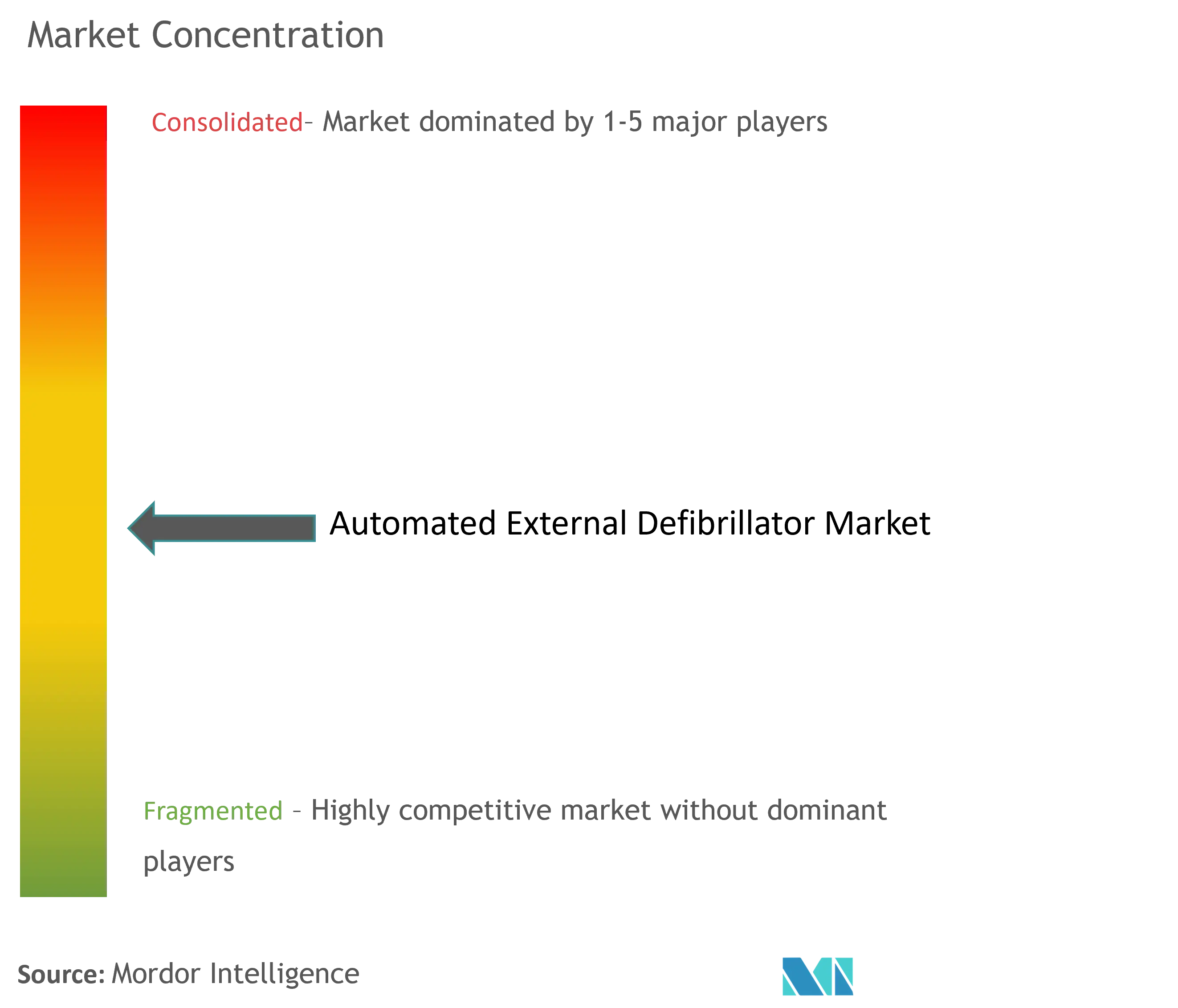
Automated External Defibrillator (AED) Market News
- February 2024: Schiller AG installed its FRED PA-1 automated external defibrillators in railroad stations in Mumbai. The installations have been strategically placed in the station master's room at Vile Parle and Santacruz stations to ensure round-the-clock accessibility and quick response in case of emergencies.
- January 2024: ZOLL Medical Corporation received approval from the European Union (EU) Medical Device Regulation 2017/745, commonly referred to as EU Medical Device Regulation (MDR) Certification for its ZOLL AED 3 defibrillator. The intent of the EU MDR is to ensure a high standard of safety and quality for medical devices that are produced in or supplied to member countries of the European Union.
Automated External Defibrillator (AED) Market Report - Table of Contents
1. INTRODUCTION
1.1 Study Assumptions and Market Definition
1.2 Scope of the Study
2. RESEARCH METHODOLOGY
3. EXECUTIVE SUMMARY
4. MARKET INSIGHTS
4.1 Market Overview
4.2 Market Drivers
4.2.1 Rising Prevalence of Cardiovascular Diseases
4.2.2 Technological Advancements in the Field of Defibrillators
4.2.3 Increasing Investments by Private Players
4.3 Market Restraints
4.3.1 Stringent Regulations
4.3.2 Lack of Awareness and Early Corrective Measures about Sudden Cardiac Arrest (SAC)
4.4 Industry Attractiveness - Porter's Five Forces Analysis
4.4.1 Threat of New Entrants
4.4.2 Bargaining Power of Buyers
4.4.3 Bargaining Power of Suppliers
4.4.4 Threat of Substitute Products
4.4.5 Intensity of Competitive Rivalry
5. MARKET SEGMENTATION (Market Size by Value - USD)
5.1 By Analysis Type
5.1.1 Semi-automated External Defibrillators
5.1.2 Fully-automated External Defibrillators
5.2 By End User
5.2.1 Hospitals/Clinics
5.2.2 Home Care
5.2.3 Other End Users
5.3 Geography
5.3.1 North America
5.3.1.1 United States
5.3.1.2 Canada
5.3.1.3 Mexico
5.3.2 Europe
5.3.2.1 Germany
5.3.2.2 United Kingdom
5.3.2.3 France
5.3.2.4 Italy
5.3.2.5 Spain
5.3.2.6 Rest of Europe
5.3.3 Asia-Pacific
5.3.3.1 China
5.3.3.2 Japan
5.3.3.3 India
5.3.3.4 Australia
5.3.3.5 South Korea
5.3.3.6 Rest of Asia-Pacific
5.3.4 Middle East and Africa
5.3.4.1 GCC
5.3.4.2 South Africa
5.3.4.3 Rest of Middle East and Africa
5.3.5 South America
5.3.5.1 Brazil
5.3.5.2 Argentina
5.3.5.3 Rest of South America
6. COMPETITIVE LANDSCAPE
6.1 Company Profiles
6.1.1 Asahi Kasei Corporation
6.1.2 Koninklijke Philips NV
6.1.3 Nihon Kohden Corporation
6.1.4 Schiller AG
6.1.5 Shenzhen Mindray Bio-Medical Electronics Co. Ltd
6.1.6 Stryker Corporation
6.1.7 CU Medical System Inc.
6.1.8 Mediana Co. Ltd
6.1.9 BPL Medical Technologies Pvt Ltd
6.1.10 Progetti Srl
6.1.11 Bexen Cardio
6.1.12 Corplus
- *List Not Exhaustive
7. MARKET OPPORTUNITIES AND FUTURE TRENDS
Automated External Defibrillator (AED) Industry Segmentation
An automated external defibrillator (AED) is a lightweight and portable device that delivers an electric shock from the chest to the heart. The shock can potentially stop an irregular heartbeat and allow a normal rhythm to resume after a sudden cardiac arrest (SCA).
The automated external defibrillator market is segmented by analysis type, end user, and geography. By analysis type, the market is segmented into semi-automated external defibrillators and fully automated external defibrillators. By end user, the market is segmented into hospitals/clinics, home care, and other end users. By geography, the market is segmented into North America, Europe, Asia-Pacific, the Middle East and Africa, and South America. For each segment, the market size is provided in terms of USD value.
| By Analysis Type | |
| Semi-automated External Defibrillators | |
| Fully-automated External Defibrillators |
| By End User | |
| Hospitals/Clinics | |
| Home Care | |
| Other End Users |
| Geography | ||||||||
| ||||||||
| ||||||||
| ||||||||
| ||||||||
|
Automated External Defibrillator (AED) Market Research FAQs
How big is the Automated External Defibrillator Market?
The Automated External Defibrillator Market size is expected to reach USD 1.60 billion in 2024 and grow at a CAGR of 8.14% to reach USD 2.40 billion by 2029.
What is the current Automated External Defibrillator Market size?
In 2024, the Automated External Defibrillator Market size is expected to reach USD 1.60 billion.
Who are the key players in Automated External Defibrillator Market?
Asahi Kasei Corporation, Stryker Corporation, Nihon Kohden Corporation, Koninklijke Philips NV and Mediana Co. Ltd. are the major companies operating in the Automated External Defibrillator Market.
Which is the fastest growing region in Automated External Defibrillator Market?
Asia Pacific is estimated to grow at the highest CAGR over the forecast period (2024-2029).
Which region has the biggest share in Automated External Defibrillator Market?
In 2024, the North America accounts for the largest market share in Automated External Defibrillator Market.
What years does this Automated External Defibrillator Market cover, and what was the market size in 2023?
In 2023, the Automated External Defibrillator Market size was estimated at USD 1.47 billion. The report covers the Automated External Defibrillator Market historical market size for years: 2019, 2020, 2021, 2022 and 2023. The report also forecasts the Automated External Defibrillator Market size for years: 2024, 2025, 2026, 2027, 2028 and 2029.
Automated External Defibrillator Industry Report
Statistics for the 2024 Automated External Defibrillator market share, size and revenue growth rate, created by Mordor Intelligence™ Industry Reports. Automated External Defibrillator analysis includes a market forecast outlook to for 2024 to 2029 and historical overview. Get a sample of this industry analysis as a free report PDF download.
